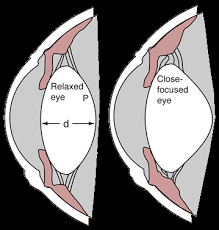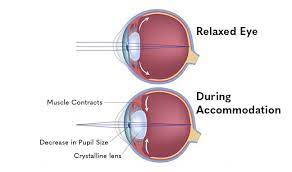

Distances vary for individuals from the far point, which is the maximum distance from the eye for which a clear image of an object can be seen, to the near point, the minimum distance for a clear image.
Accommodation usually acts like a reflex.
Accommodation includes part of the accommodation-vergence reflex, but it can also be consciously controlled.
Variation in the eye’s optical power occurs by changing the form of the elastic lens using the ciliary body up to 15 dioptres in the mean.
The human eye can change focus from distance at infinity to as near as 6.5 cm from the eye.
The change in focal power of the eye of approximately 15 dioptres occurs due to a reduction in zonular tension induced by ciliary muscle contraction.
This change can occur in as little as 224 ± 30 milliseconds in bright light.
Accommodation amplitude declines with age.
By the fifth decade of life accommodation amplitude declines so that the near point of the eye is more remote than the reading distance, causing presbyopia.
When presbyopia occurs, those who
do not require optical correction for distance vision (emmetropia) will need an optical aid for near vision.
For those who are myopic, nearsighted, and require an optical correction for distance vision, will find that they see better at near without their distance correction; and those who are hyperopic, farsighted, will find that they may need a correction for both distance and near vision.
The above effects are most noticeable when the pupil is large; in dim light.
Age-related decline in eye accommodation occurs almost universally to less than 2 dioptres by the time a person reaches 45 to 50 years: people notice a decrease in their ability to focus on close objects and hence require glasses for reading or bifocal lenses.
Accommodation decreases to about 1 dioptre at the age of 70 years.
When viewing a distant object, the circularly arranged ciliary muscle relaxes allowing the lens zonules and suspensory ligaments to flatten the lens by pulling on it.
Pressure tension resultsfrom the vitreous and aqueous humours on the sclera
The ciliary muscles contract, resisting the outward pressure on the sclera, when viewing a neat object causing the lens zonules to slacken which allows the lens to spring back into a thicker, more convex, form.
Accommodation to a near object, also converges the eyes and, as a result, constrict their pupils.
The constriction of the pupils is not part of the process called lens accommodation.
The combination of these three movements,accommodation, convergence and miosis is under the control of the Edinger-Westphal nucleus.
There is a measurable ratio between how much convergence takes place because of accommodation, and when abnormal
can lead to binocular vision problems.
Anomalies of accommodation can be decreased or increased.
Decreased accommodation may occur due to physiological-presbyopia, pharmacological-cycloplegia or pathological reasons.
Excessive accommodation and spasm of accommodation are types of increased accommodation.
Presbyopia, physiological insufficiency of accommodation due to age related changes in lens.
Presbyopia lens have decreased elasticity and increased hardness.
Ciiliary muscle power is the commonest form of accommodative dysfunction, causing gradual decrease in near vision.
Accommodative insufficiency refers to the condition where amplitude of accommodation of a person is lesser compared to physiological limits for their age.
Premature sclerosis of lens or ciliary muscle weaknesses due to systemic or local cases may cause accommodative insufficiency.
Ill-sustained accommodation is a condition similar to accommodative insufficiency, that occurs after excessive near work accommodative power usage.
Paralysis of accommodation occurs when the amplitude of accommodation is either markedly reduced or completely absent (cycloplegia).
Paralysis of accommodation may occur due to ciliary muscle paralysis or occulomotor nerve paralysis.
Parasympatholytic drugs like atropine cause paralysis of accommodation.
Unequal accommodation occurs If there is amplitude of accommodation between the eyes differ 0.5 dioptre or more.
Organic diseases, head trauma or functional amblyopia may be responsible for unequal accommodation.
Accommodative infacility is also known as accommodative inertia, is a rare condition with difficulty in changing accommodation from one point to other.
There may be difficulty in adjusting focus from distance from near, with accommodative infacility.
Spasm of accommodation (ciliary spasm) is a condition of abnormally excessive accommodation which is out of voluntary control of the person.
Accommodative excess occurs when an individual uses more than normal accommodation for performing certain near work.
